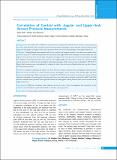Please use this identifier to cite or link to this item:
https://hdl.handle.net/20.500.14356/1192Full metadata record
| DC Field | Value | Language |
|---|---|---|
| dc.contributor.author | Karki, Sanjit | - |
| dc.contributor.author | Bhattarai, Madhur Dev | - |
| dc.date.accessioned | 2023-05-02T08:55:25Z | - |
| dc.date.available | 2023-05-02T08:55:25Z | - |
| dc.date.issued | 2020 | - |
| dc.identifier.citation | KarkiS., & BhattaraiM. D. (2020). Correlation of Central with Jugular and Upper-limb Venous Pressure Measurements. Journal of Nepal Health Research Council, 18(1), 35-40. https://doi.org/10.33314/jnhrc.v18i1.2406 | en_US |
| dc.identifier.issn | JNHRC Print ISSN: 1727-5482; Online ISSN: 1999-6217 | - |
| dc.identifier.uri | http://103.69.126.140:8080/handle/20.500.14356/1192 | - |
| dc.description | Original Article | en_US |
| dc.description.abstract | Abstract Background: Correlation data of different external reference points and methods used to measure venous pressures are scarce in the literature. We correlated central venous pressure with jugular venous pressure measured from sternal angle and with jugular and upper-limb venous pressures from zero level corresponding to mid-right-atrium level. Methods: A hospital-based observational study in the medical and surgical intensive care units was conducted for period of one year.” Central venous pressure was measured from right fourth intercostal space in mid-axillary line and jugular venous pressure from sternal angle and jugular and upper-limb venous pressures from horizontal plane through the midpoint of anteroposterior line from anterior end of right fourth intercostal space to back. We measured central venous pressure by central venous cannulation and jugular and upper-limb venous pressures clinically by JVP Meter®. Upper-limb venous pressure was indicated by collapse of visible veins in dorsum of hands as the arm was slowly raised from dependent position. Results: Correlation coefficient (r) values were 0.61 between central venous pressure and jugular venous pressure from zero level, 0.48 between central venous pressure and jugular venous pressure from sternal angle, and 0.31 between central and upper-limb venous pressures; and 0.67 and 0.50 between central venous pressure measured from right internal jugular vein and jugular venous pressure from zero level and sternal angle respectively and0.52 and 0.44 between central venous pressure from right sub-clavian vein and jugular venous pressure from zero level and sternal angle respectively. Conclusions: Different correlation values indicate the need to have future investigations and consensus on the common external reference point and methods to measure venous pressures. Keywords: CVP; heart failure; JVP; JVP Meter; shock | en_US |
| dc.language.iso | en | en_US |
| dc.publisher | Nepal Health Research Council | en_US |
| dc.relation.ispartofseries | Jan-Mar 2020;2406 | - |
| dc.subject | CVP | en_US |
| dc.subject | Heart failure | en_US |
| dc.subject | JVP | en_US |
| dc.subject | JVP Meter | en_US |
| dc.subject | Shock | en_US |
| dc.title | Correlation of Central with Jugular and Upper-limb Venous Pressure Measurements | en_US |
| dc.type | Journal Article | en_US |
| local.journal.category | Original Article | - |
| Appears in Collections: | Vol. 18 No. 1 (2020): Vol. 18 No. 1 Issue 46 Jan-Mar 2020 | |
Files in This Item:
| File | Description | Size | Format | |
|---|---|---|---|---|
| 2406-Manuscript-14302-1-10-20200420.pdf | Fulltext Article. | 384.12 kB | Adobe PDF |  View/Open |
Items in DSpace are protected by copyright, with all rights reserved, unless otherwise indicated.
